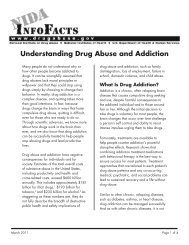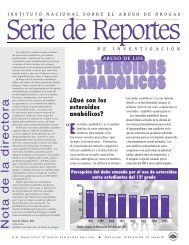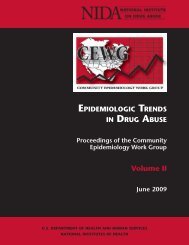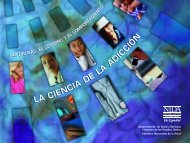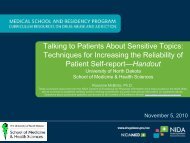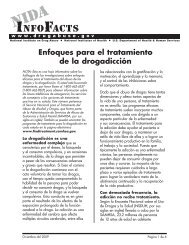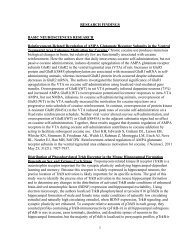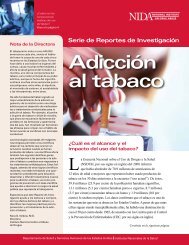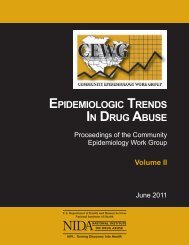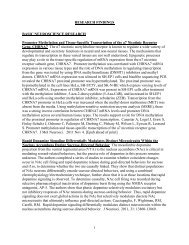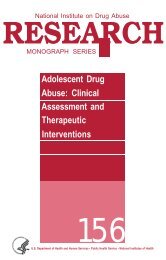CEWG January 09 Full Report - National Institute on Drug Abuse
CEWG January 09 Full Report - National Institute on Drug Abuse
CEWG January 09 Full Report - National Institute on Drug Abuse
Create successful ePaper yourself
Turn your PDF publications into a flip-book with our unique Google optimized e-Paper software.
Secti<strong>on</strong> III. <str<strong>on</strong>g>CEWG</str<strong>on</strong>g> Area Update Briefs and Internati<strong>on</strong>al Presentati<strong>on</strong>s<br />
district data available through 2007. Youth Risk<br />
Behaviour Study data, also previously reported<br />
to <str<strong>on</strong>g>CEWG</str<strong>on</strong>g> in June 2008, were from <strong>on</strong>line reports<br />
as of 06/04/2008. Pois<strong>on</strong> C<strong>on</strong>trol System data<br />
were provided by the CPCS for 2007 and <str<strong>on</strong>g>January</str<strong>on</strong>g>–<br />
September 2008.Updates from other data sources<br />
were not available for this report.<br />
<strong>Drug</strong> <strong>Abuse</strong> Patterns and Trends in<br />
Maine—Update: <str<strong>on</strong>g>January</str<strong>on</strong>g> 20<str<strong>on</strong>g>09</str<strong>on</strong>g><br />
Marcella Sorg, Ph.D., R.N., D-ABFA<br />
For inquiries c<strong>on</strong>cerning this report, please c<strong>on</strong>tact<br />
Marcella H. Sorg, Ph.D., R.N., D-ABFA, Director,<br />
Rural <strong>Drug</strong> and Alcohol Research Program, Margaret<br />
Chase Smith Policy Center, University of Maine,<br />
Building 4, 5784 York Complex, Or<strong>on</strong>o, ME 04469<br />
5784, Ph<strong>on</strong>e: 207–581–2596, Fax: 207–581–1266,<br />
E-mail: marcella.sorg@umit.maine.edu.<br />
Overview of Findings: This report updates<br />
drug abuse indicators in Maine, arrests and seizures<br />
through calendar year 2008, and deaths and<br />
treatment admissi<strong>on</strong>s through the first half of<br />
the year. Several drug categories showed mixed<br />
or c<strong>on</strong>flicting patterns. Most heroin indicators<br />
declined in 2008, c<strong>on</strong>tinuing a multi-year trend,<br />
although seizures increased slightly. Cocaine<br />
abuse, which had been growing str<strong>on</strong>gly through<br />
2007, declined across most indicators, with the<br />
excepti<strong>on</strong> of a slight increase in cocaine powder<br />
primary admissi<strong>on</strong>s through June 2008.<br />
Decreases were seen for cocaine and crack arrests<br />
and seizures, as well as for primary cocaine<br />
powder admissi<strong>on</strong>s. The decreasing number of<br />
cocaine-induced deaths during the first 6 m<strong>on</strong>ths<br />
of 2008 suggests a possible downturn for the year.<br />
Marijuana indicators c<strong>on</strong>tinued to be moderately<br />
high, with arrests, seizures, and primary admissi<strong>on</strong><br />
levels stable or in gradual decline for the last<br />
several years. Although the percentage of primary<br />
marijuana admissi<strong>on</strong>s decreased in the first half of<br />
2008, the number of admissi<strong>on</strong>s increased. <strong>Abuse</strong><br />
of prescripti<strong>on</strong> drugs, predominantly methad<strong>on</strong>e,<br />
oxycod<strong>on</strong>e, and benzodiazepines, c<strong>on</strong>tinued<br />
at high and increasing levels; these drugs are<br />
frequently used in combinati<strong>on</strong> with each other<br />
or with alcohol. The percentage of deaths caused<br />
by <strong>on</strong>e or more prescripti<strong>on</strong> drugs in 2007 was<br />
86 percent, rising to 95 percent in the first half of<br />
2008, as the overall number of prescripti<strong>on</strong>s written<br />
statewide for Schedule II, III, and IV drugs<br />
c<strong>on</strong>tinued to rise. During the sec<strong>on</strong>d half of 2007,<br />
primary admissi<strong>on</strong>s for prescripti<strong>on</strong> drugs began<br />
to exceed those for illicit drugs, a trend that c<strong>on</strong>tinued<br />
into the first half of 2008. Am<strong>on</strong>g narcotic<br />
analgesics, seizures through 2008 for methad<strong>on</strong>e<br />
and buprenorphine were higher, as well as primary<br />
treatment admissi<strong>on</strong>s for oxycod<strong>on</strong>e and<br />
methad<strong>on</strong>e through the first half of 2008. Methad<strong>on</strong>e-induced<br />
deaths leveled off at 36 percent of<br />
drug deaths, and benzodiazepine-induced deaths<br />
rose to 26 percent through the first 6 m<strong>on</strong>ths of<br />
the year. The proporti<strong>on</strong> of arrests for pharmaceuticals<br />
increased from 21 to 29 percent through<br />
2008, and pharmaceutical arrests dominated<br />
other drug categories, exceeding the percentage of<br />
cocaine arrests. Methamphetamine abuse indicators<br />
were mixed, and the numbers were still quite<br />
low. The majority of methamphetamine seizures<br />
were tablets c<strong>on</strong>taining caffeine, some c<strong>on</strong>taining<br />
MDMA as well. The numbers of MDMA seizures<br />
and arrests have increased but remain low<br />
in number. The proporti<strong>on</strong> of MDMA treatment<br />
admissi<strong>on</strong>s fell sharply in 2007 to nearly zero, and<br />
has remained there through June 2008.<br />
Updated <strong>Drug</strong> Trends and Emerging Patterns:<br />
Heroin abuse remained a serious problem<br />
but recent indicators have been stable or<br />
decreasing. Heroin/morphine caused 13 percent<br />
of <str<strong>on</strong>g>January</str<strong>on</strong>g>–June drug-induced deaths in 2008,<br />
compared with 16 percent in 2007, c<strong>on</strong>tinuing<br />
to decline from a peak of 25 percent in 2005. Six<br />
percent of 2008 arrests were for heroin, down<br />
slightly from 7 percent in 2007. Heroin seizures<br />
rose slightly between 2007 and 2008, from 7 to<br />
8 percent. Primary heroin/morphine admissi<strong>on</strong>s<br />
for the first half of 2008 were down to 13 percent,<br />
c<strong>on</strong>tinuing a decline since the peak of 22 percent<br />
in the sec<strong>on</strong>d half of 2005. Cocaine and prescripti<strong>on</strong><br />
narcotics remained the two leading types of<br />
Proceedings of the Community Epidemiology Work Group, <str<strong>on</strong>g>January</str<strong>on</strong>g> 20<str<strong>on</strong>g>09</str<strong>on</strong>g> 51



